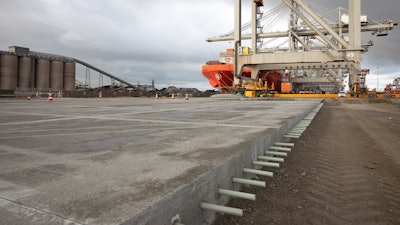The Benefits of Using Composites in Building And Construction Materials
The Benefits of Using Composites in Building And Construction Materials
Blog Article
Opening the Ecological Advantages of Recycled Composites in Construction and Design
In the world of building and design, the application of recycled compounds holds considerable promise for boosting sustainability methods and minimizing ecological effect. The shift in the direction of a more lasting future in these sectors hinges on unlocking the full capacity of recycled compounds.

Ecological Impact Reduction
The reduction of ecological effect via the usage of recycled composites in construction and design plays an important duty in lasting practices. By including recycled composites right into building materials, the construction market can considerably reduce its carbon footprint and add to a much more green future. These sustainable products, made from repurposed plastics, timber fibers, or other recycled elements, use a practical choice to traditional building materials without endangering on top quality or toughness.
Recycled compounds help divert waste from garbage dumps and minimize the requirement for extracting raw products, hence saving natural deposits. In addition, the manufacturing process of these composites frequently takes in less energy and gives off less greenhouse gases contrasted to producing virgin products (composites). This change in the direction of using recycled compounds not just lessens environmental damage however additionally advertises a round economic situation by urging the reuse of products that would otherwise be discarded
Waste Reduction
With a concentrate on reducing waste in construction and layout, the combination of recycled compounds supplies a sustainable option to minimize environmental influence. Waste minimization is a crucial aspect of sustainable methods, and making use of recycled composites offers a chance to attain this objective properly. By utilizing materials that have actually currently offered their initial function, such as recycled plastics or recovered timber fibers, the building and construction and style sectors can substantially lower the amount of waste created and sent out to garbage dumps.
Recycled compounds have the prospective to draw away substantial amounts of waste from standard disposal methods, adding to an extra circular economic climate where sources are made use of effectively. In addition, the production process of recycled compounds usually eats less power and generates fewer exhausts compared to virgin products, further minimizing the environmental footprint of building and style projects.
Carrying out waste reduction approaches through the unification of recycled composites not just assists in conserving natural resources however additionally advertises a much more sustainable approach to building and developing for a greener future.
Power Conservation
Including recycled compounds not only lessens waste in building and construction and design but likewise plays a crucial duty in boosting energy conservation practices within the sector. Making use of recycled composites in construction can dramatically contribute to power preservation with different methods. First of all, the production of virgin materials generally needs considerable energy inputs, whereas utilizing recycled compounds takes in much less power, therefore lowering overall energy consumption. Additionally, including recycled compounds can add to better insulation buildings in structures, reducing the demand for excessive heating or cooling, and subsequently reducing power use for climate control. Additionally, the lightweight nature of numerous recycled compounds can lead to lighter frameworks, needing less energy for transportation and her latest blog setup. By promoting the use of recycled composites in building and construction and layout, the industry can make considerable strides towards attaining energy efficiency and decreasing its carbon impact, ultimately adding to a more lasting built atmosphere.
Carbon Impact Decrease
Enhancing sustainability practices through the usage of recycled compounds in building and construction and layout considerably lowers the carbon impact of the market. By incorporating recycled materials into the manufacturing of composites, the demand for virgin resources lowers, bring about lower power consumption and greenhouse gas emissions linked with conventional production procedures. This decrease in carbon footprint is important in combating climate modification and advertising a more eco-friendly method to building and construction and layout.
Furthermore, the usage of recycled composites also assists in diverting waste from landfills, thereby reducing the environmental influence of disposal and promoting a circular economy. The carbon footprint decrease achieved via the adoption of go to my blog recycled compounds lines up with the global press in the direction of lasting techniques and the reduction of industrial emissions. It showcases a commitment to accountable resource management and a change towards greener alternatives in the construction and design sectors. Eventually, by prioritizing the integration of recycled composites, the sector can make substantial strides in reducing its carbon footprint and adding to a more sustainable future.
Lasting Future
The combination of recycled compounds in building and construction and design not only addresses prompt environmental concerns yet also lays a strong foundation for a sustainable future in the market. By including recycled composites into building materials and items, the building and construction and design markets can substantially decrease their reliance on virgin resources, leading to a much more round economic climate. This shift towards sustainability is vital for mitigating the environmental influence of standard building and construction methods, which often cause high levels of waste generation and resource exhaustion.

Conclusion
To conclude, recycled compounds offer considerable ecological advantages in building and construction and style by minimizing ecological impact, lessening waste, preserving energy, reducing carbon impact, and advertising a sustainable future. Accepting using recycled compounds can contribute to a more environmentally-friendly strategy to structure and layout, ultimately leading to an extra lasting and greener future for all.
The reduction of ecological impact with the usage of recycled compounds in building and construction and design plays an essential duty in sustainable methods.With a focus on decreasing waste in building and construction and design, the combination of recycled composites offers a lasting option to decrease environmental influence. By look at here advertising the use of recycled compounds in building and layout, the industry can make significant strides in the direction of attaining power effectiveness and reducing its carbon footprint, inevitably contributing to an extra sustainable built atmosphere.

Report this page